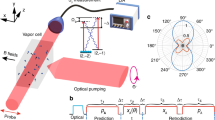Abstract
The macroscopic quantum systems are considered as a bridge between quantum and classical systems. In this study, we explore the validity of the original Heisenberg position–momentum uncertainty relation for a macroscopic harmonic oscillator interacting with environmental micro-particles. Our results show that, in the quasi-classical situation, the original uncertainty relation does not hold, when the number of particles in the environment is small. Nonetheless, increasing the environmental degrees of freedom removes the violation bounds in the regions of our investigation.

Similar content being viewed by others
References
Leggett, A.J.: Macroscopic quantum systems and the quantum theory of measurement. Prog. Theo. Phys. 69, 80–100 (1980)
Leggett, A.J., Garg, A.: Quantum mechanics versus macroscopic realism: Is the flux there when nobody looks? Phys. Rev. lett. 54, 857–860 (1985)
Leggett, A.J.: Quantum mechanics at the macroscopic level. In: Souletie, J., Vannimenus, J., Stora, J. (eds.) Chance and Matter. Elsevier Science Publishers, Amsterdam (1987)
Takagi, S.: Macroscopic Quantum Tunneling. Cambridge University Press, New York (2005)
Caldeira, A.O.: An Introduction to Macroscopic Quantum Phenomena and Quantum Dissipation. Cambridge University Press, New York (2014)
Yang, L.P., Cai, C.Y., Xu, D.Z., Sun, C.P.: Exact non-Markovian master equation and dispersive probing of non-Markovian process. arXiv:1209.5510 (2012)
Schlosshauer, M.: Decoherence and the Quantum to Classical Transition. Springer, Berlin (2007)
Joos, E., Zeh, H.D.: The emergence of classical properties through interaction with the environment. Z. Phys. B: Condens. Matter 59, 223–243 (1985)
Anastopoulos, C., Halliwell, J.J.: Generalized uncertainty relations and long-time limits for quantum Brownian motion models. Phys. Rev. D 51, 6870–6885 (1995)
Ozawa, M.: Universally valid reformulation of the Heisenberg uncertainty principle on noise and disturbance in measurement. Phys. Rev. A 67, 042105 (2003)
McDermott, R.M., Redmount, I.H.: Coupled classical and quantum oscillators. arXiv:quant-ph/0403184 (2004)
Ozawa, M.: Physical content of Heisenberg’s uncertainty relation: limitation and reformulation. Phys. Lett. A 318, 21–29 (2003)
Ozawa, M.: Uncertainty relations for joint measurements of noncommuting observables. Phys. Lett. A 320, 367–374 (2004)
Werner, R.F.: The uncertainty relation for joint measurement of position and momentum. arXiv:quant-ph/0405184 (2004)
Busch, P., Heinonen, T., Lahti, P.: Heisenberg’s uncertainty principle. Phys. Rep. 452, 155–176 (2007)
Rozema, L., Darabi, A., Mahler, D., Hayat, A., Soudagar, Y.: Violation of Heisenberg’s measurement-disturbance relationship by weak measurements. Phys. Rev. Lett. 109, 100404 (2012)
Sulyok, G., Sponar, S., Erhart, J., Badurek, G., Ozawa, M., Hasegawa, Y.: Violation of Heisenberg’s error-disturbance uncertainty relation in neutron-spin measurements. Phys. Rev. A 88, 022110 (2013)
Tirandaz, A., Shafiee, A.: Spin uncertainty relation under decoherence. Quantum Stud.: Math. Found. 3, 189–201 (2016)
Author information
Authors and Affiliations
Corresponding author
Appendix
Appendix
Here, we derive the violation range of uncertainty relation, when the system is coupled to three particles of the environment. Considering a given violation range as
One can show that the product of \(\langle q^2\rangle \langle p^2\rangle \) in relations (30) and (31) leads to:
where \(a^2+b^2=1\) and d is defined. The above relation is simplified to \( 1/4\pi ^2(3)^3\), after some mathematical manipulation. This concludes the relation (38) for \(N=3\). The same method could be used to prove similar results for other Ns.
Rights and permissions
About this article
Cite this article
Naeij, H.R., Shafiee, A. Position–Momentum Uncertainty Relation for an Open Macroscopic Quantum System. J Stat Phys 165, 1141–1152 (2016). https://doi.org/10.1007/s10955-016-1666-x
Received:
Accepted:
Published:
Issue Date:
DOI: https://doi.org/10.1007/s10955-016-1666-x




